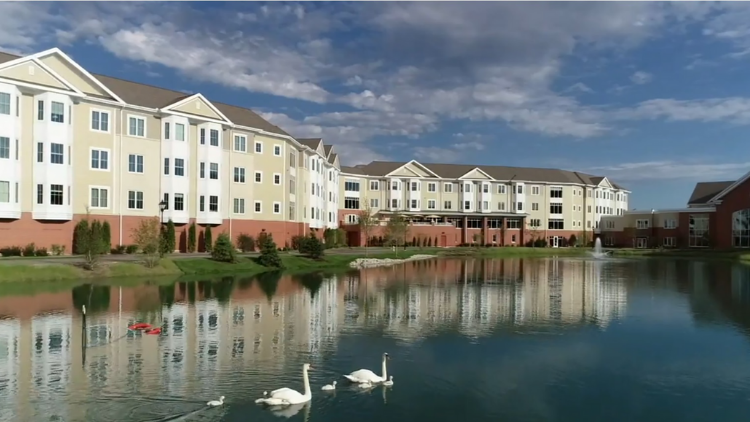Cats, Dogs, and Other Critters are Welcome at Retirement Communities

It’s a dog’s life — and not that bad after all.
Bella, a 17-pound Cavalier King Charles Spaniel, lives at Lake Forest Place, a retirement community in the northern suburb. Or perhaps it’s more accurate to say Bella lives with her owners Fay and Gerry Ligon who have a cottage on the Lake Forest Place campus.
The dog-loving couple moved here from Rhode Island and would not have considered living in a retirement community that did not permit pets. Bella has her own yard at the couple’s cottage. The campus even has a dog park where Bella can run around unleashed and play with other dogs.
“We can’t imagine not having a dog,” says Fay. “We love dogs.”
Just as dogs are becoming more a part of everyday life — now seen riding on planes and tagging along in stores — retirement communities are loosening their rules on pets.
Cats and dogs are generally welcome at communities for independent retirees. Many life care communities like Lake Forest Place, and active adult-type developments, such as the Del Webb projects, include single-family homes with yards — a big plus for dogs and their owners.
Lake Forest Place, a 60-acre life care community operated by Presbyterian Homes, added 14 cottages with yards to its campus last year.
Some communities have restrictions on the size and number of pets, not unlike the rules at condominiums that govern pet ownership. Retirement communities typically stipulate that residents must be able to care for the pet and dogs must be leashed when in common areas or outside
“Pets are so important,” says Renee Cerveny, senior vice president of senior living at Lexington Square, which operates life care communities in Lombard and Elmhurst. “Pets give residents a purpose because pets have to be taken care of, and they offer unconditional love.”
Smith Crossing, a life care retirement community in Orland Park, allows pets for residents of independent living apartments. Resident Eileen Doran likes to sail and named her cat, Mariah, after the song about the wind. “She’s a good friend. You can talk to her,” says Doran. “She doesn’t answer back, but it seems like there’s someone to have an interchange with.”
Case-by-case basis
Assisted living communities are less likely to allow pets, but some do. Jacqy Carnahan has a 30-pound cat, Bailey, named after Bailey’s Irish Cream because he’s the same color as the drink. They live together at Belmont Village Senior Living in Oak Park, an assisted living community.
Like a lot of pet owners, Carnahan wouldn’t have moved to Belmont Village without Bailey. “My daughter hunted for a place that would accept Bailey,” says Carnahan. “It was a deal breaker.”
Caily O’Donovan, executive director at Belmont Village in Oak Park, meets with residents and their families prior to move in. Pets need her approval.
“Moving to a senior living community is difficult enough without losing a companion pet,” says O’Donovan, who brings her own dog, Freddie, with her to work at the building on Thursdays. “Pets are so beneficial to the residents’ social and mental well being.”
Long-time pets usually move in with their owners. But communities will allow new pets too.
Anne Zeidman, a retired social worker, was petless when she and her husband moved three years ago to Montgomery Place, a retirement community in Chicago’s Hyde Park neighborhood. “I thought I would never have another dog,” says Zeidman.
But her daughter, a dog groomer in San Francsico, brought Zeidman a rescued Pomeranian, named Bitsy, for her birthday. “It’s such a comfort to sit and read with this little soul there. A dog adds a lot of pleasure to life,” says Zeidman.
Another benefit is exercise, both for the dog and the owner. “I love to walk,” says Zeidman, who walks seven-pound Bitsy every morning. “We get suited up and go out.” Bitsy wears red rubbers and a coat in winter.
Residents of senior living communities rely on neighbors or outside services to help with pet care. Zeidman has a dog walker who takes Bitsy out in the afternoon with another dog that lives at Montgomery Place.
Senior living communities can usually help arrange or find dog walking or pet care services. Building staff can also help out if an emergency arises. But it’s a good idea to have a back-up care plan just in case, building managers say.
Visiting pets also welcome
Not everyone is able to have a pet. But that doesn’t mean retirement communities are petless. Therapy dogs and family pets are brought in to see the residents.
Several times a month, trained therapy dogs visit Lexington Square of Lombard and of Elmhurst. The dogs interact with residents and like being petted. The residents love it too. “Everyone enjoys the dogs,” says Cerveny of Lexington Square. “It’s a real benefit.”
Some buildings have their own community pets. Elaborate cages that hold bird colonies for residents to watch have become a popular feature in assisted living communities. The same goes for fish aquariums.
Monarch Landing, a retirement community in Naperville, has its own facility dog named Journey. The shepherd-retriever mix lives with Melissa Hegg, and they both work at Monarch Landing.
Journey hangs out in Hegg’s office when he’s not on duty. He’s made friends with other dogs who live at Monarch Landing. He even has a girlfriend, a white shepherd named Lucy.
When Journey is working, he’s assigned to the community’s life enrichment department. He tours the building with a handler, dropping in on residents. When Journey hears the word “visit,” he has been trained to go to the resident and say hello. “He’ll find the person’s hand, or lean against their wheelchair so they can pet him,” says Hegg.
Sometimes he shows off. Journey can pick up objects on command, flip on light switches, and press the button to open a handicap door. “Residents love it,” says Hegg. “They kind of light up.”



